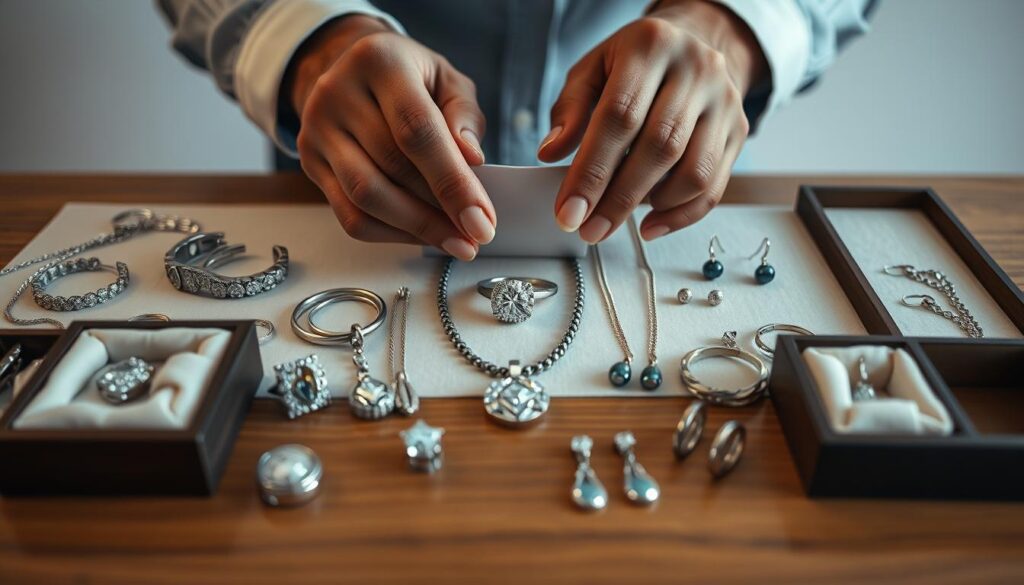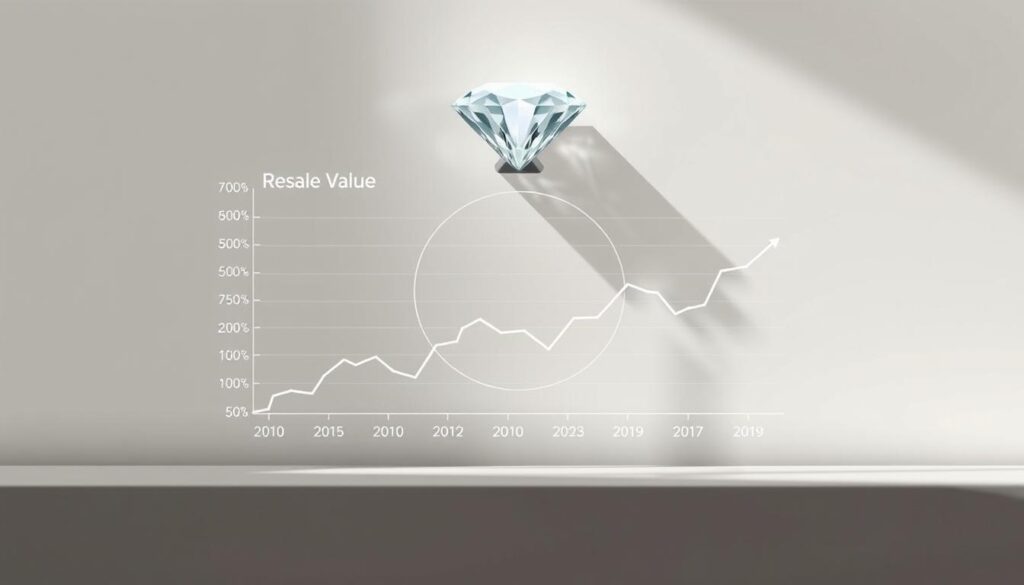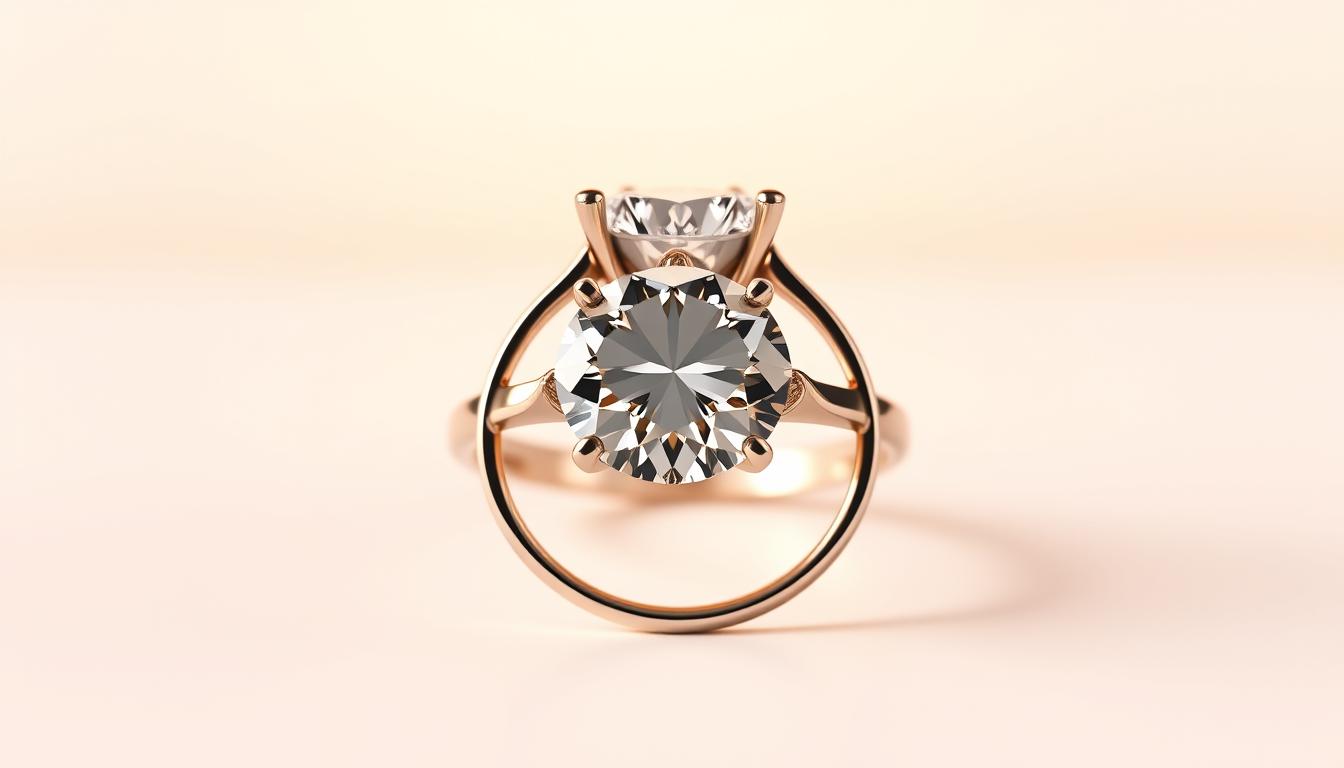Letting go of a cherished piece of jewelry often feels like releasing a chapter of your life. Whether it’s an heirloom passed through generations or a symbol of love that no longer fits your story, the decision deserves care and clarity. Many find themselves navigating this journey with equal parts hope and hesitation.
Modern markets offer exciting opportunities to connect with buyers nationwide. Online platforms frequently provide better pricing than local stores, but knowing where to start remains a common hurdle. Understanding your item’s true worth is the first step toward a fair transaction.
Most owners recover 20-50% of their original investment, even for flawless pieces. This reality underscores the importance of research and patience. Scams exist, but so do reputable professionals eager to help you succeed.
This guide simplifies every phase—from appraisal to payment. You’ll learn how to spot trustworthy buyers and avoid costly mistakes. Together, we’ll transform uncertainty into confidence, honoring both your memories and practical needs.
Your jewelry’s next chapter begins here.
Understanding the Diamond Market and Value
Decoding the ever-changing gem market can feel like mastering a new language. Unlike traditional luxury markets, values here shift with geopolitical events and consumer preferences. A stone’s worth today might differ tomorrow based on mining outputs or economic indicators.
Current Trends in Diamond Pricing
Round cuts dominate demand, holding 30% higher resale value than other shapes. Seasonal spikes occur during engagement periods (November-February), creating optimal windows for transactions. Lab-grown alternatives now capture 18% of the market, affecting natural stone valuations.
Three key forces shape market prices:
- Wholesale cash offers (lowest immediate payout)
- Retail consignment options (higher potential returns)
- Specialized buyer networks (nicme expertise premiums)
Key Factors Influencing Value
Beyond the 4 Cs, designer labels like Tiffany & Co. command 15-25% premiums. Vintage pieces with provenance stories often outperform modern equivalents. Recent surges in colored stones and asymmetrical designs reveal fashion’s impact on valuations.
Remember: No two appraisals match exactly. A 1-carat stone might receive offers ranging from $2,800-$4,200 based on current inventories and buyer competition. Tracking auction results through platforms like Worthy.com provides real-time market snapshots.
Evaluating Your Diamond Ring’s Quality and Certification
Assessing a precious gem’s worth combines science and artistry. While emotional connections shape personal value, professionals use standardized metrics to determine market potential. Let’s explore the universal grading system that shapes every transaction.
The 4 Cs: Cut, Color, Carat, and Clarity
Cut quality acts as the gem’s fingerprint, dictating how light dances through its facets. Superior craftsmanship transforms rough stones into radiant treasures, with proportions affecting sparkle more than size.
The color scale ranges from icy D-grade (pure white) to warmer Z hues. Even subtle variations impact appeal – a single grade difference might alter offers by 5-8%.
- Carat measures weight, not visual size
- Clarity grades (FL to I3) map natural imperfections
- Shape popularity affects desirability
Certification from labs like GIA provides trusted quality verification. These reports detail all four Cs plus fluorescence and symmetry. Pro tip: Stones with paperwork typically fetch 10-15% higher prices than undocumented equivalents.
Remember – settings and metal purity also influence final quotes. A platinum band with secure prongs often boosts confidence in craftsmanship. Always request multiple evaluations to uncover hidden strengths in your piece.
Preparing Your Diamond Ring for Sale
Presenting your jewelry in its best light transforms potential buyers’ first impressions. A well-prepared piece tells its story through sparkle and documentation, building trust before negotiations begin. Let’s explore how to showcase your item’s true potential.

Cleaning and Professional Appraisal
Start with gentle cleaning using warm water and a soft-bristle toothbrush. Avoid harsh chemicals that could damage delicate settings. For intricate designs or vintage items, consider professional cleaning services – they often use ultrasonic technology to restore brilliance safely.
Obtain updated appraisals from certified gemologists. These documents verify quality characteristics and current market value. Original certificates from GIA or AGS significantly increase buyer confidence, especially for high-value pieces.
Documenting and Photographing Your Piece
Capture your jewelry’s beauty with these photography essentials:
- Use natural light against neutral backgrounds
- Showcase unique angles and close-up details
- Include shots of hallmarks and certification numbers
Pair images with concise descriptions highlighting craftsmanship and history. Mention distinctive features like hand-engraved patterns or rare stone arrangements. Digital backups of paperwork ensure you’re ready for serious inquiries while protecting original documents.
Selling Diamond Ring: Tips for Online Success
Navigating digital marketplaces requires equal parts strategy and creativity. Your jewelry deserves visibility beyond crowded platforms, where serious collectors and sentimental buyers actively search.
Maximizing Your Online Presence
General platforms like eBay reach broad audiences but lack specialized buyer protections. Niche jewelry sites offer curated traffic, often resulting in faster sales at competitive rates. Consider these elements when choosing where to list:
- Fee structures (5-12% commission averages)
- Built-in authentication services
- Escrow payment options
Optimize titles using terms like “certified solitaire” or “vintage three-stone design.” Include specific measurements and certification numbers – transparency builds trust. Research completed sales of similar items to set realistic prices.
Listings gain traction when timed with engagement seasons (December-January) or holiday gift periods. Respond to inquiries within 4 hours – delayed replies correlate with 40% lower conversion rates.
Always use tracked shipping with signature confirmation. Payment platforms like PayPal Goods & Services protect both parties, though they deduct 3% fees. Meet buyers in secure locations if local exchanges occur.
Selecting the Best Selling Option: Online vs Local
Choosing where to sell your jewelry feels like picking the right key for a locked treasure chest. Each option unlocks different benefits and trade-offs. Let’s explore how traditional and digital avenues stack up in today’s market.
Local Jewelry Stores and Pawn Shops Compared
Walking into a neighborhood jewelry store offers instant cash and face-to-face service. However, these local jewelry shops often pay 40-70% less than online specialists. Their limited client networks and physical overhead eat into profit margins.
Pawn shops work best for urgent needs but typically offer rock-bottom prices. Their business model requires resale profits, leaving sellers with 30-60% of true value. One client received $850 at a pawnbroker versus $2,100 from an online expert for the same piece.
Working with Specialized Online Buyers
Digital platforms like Abe Mor connect your item to global buyers through secure processes. These jeweler networks use competitive bidding, often delivering 20-50% higher offers than physical stores. Their expertise in rare stones and vintage designs adds value invisible to local shops.
Three advantages define top online options:
- Free shipping with insurance coverage
- Transparent price comparisons
- Certified gemologist evaluations
Always request quotes from multiple places before deciding. Reputable companies provide detailed breakdowns without pressure to accept offers. This approach helped one seller increase their final payout by 62% through competitive bidding.
Understanding Resale Value and Market Prices
The journey from retail purchase to resale often reveals surprising financial realities. Jewelry value behaves differently than other assets, with most pieces losing significant money initially. This isn’t about quality – it’s about how the market works.

Calculating Resale Percentages and Loss Expectations
Retail markups create the biggest gap. Stores typically charge 100-400% above wholesale prices. A $5,000 piece might have cost them $1,250. When reselling, you’ll compete with stores buying at wholesale rates.
Consider these real-world scenarios:
- A luxury boutique purchase: $8,000 retail → $2,400 resale (30%)
- An online retailer piece: $3,500 retail → $1,575 resale (45%)
- Wholesale-direct stone: $4,000 cost → $3,600 resale (90%)
Three factors help minimize losses:
- Choose classic cuts over trendy designs
- Keep original certifications and receipts
- Time your sale during peak demand months
While 20-50% returns are common, strategic sellers can outperform averages. One client recovered 68% by waiting for market shifts favoring their stone’s unique color. Always calculate your bottom line using current wholesale prices, not sentimental attachments.
Negotiating and Pricing Your Diamond Ring Perfectly
Price discussions require equal parts confidence and flexibility. Start by researching comparable listings on platforms like eBay and Worthy. Note how similar items perform—this creates a realistic foundation for your numbers.
Setting Your Bottom Line and Strategy
Establish your absolute minimum price before talking to buyers. This “walk-away number” protects you from rushed decisions. A good rule? Set your initial ask 25% above this threshold to allow room for compromise.
Three steps refine your approach:
- Compare recent sale prices of items with matching certifications
- Factor in seasonal demand shifts (higher offers around holidays)
- Prepare documentation to justify your valuation
“The prepared seller always controls the conversation,” notes GIA-certified appraiser Lisa Donovan. Use phrases like “market research shows” instead of emotional appeals. If offers fall short, respond with curiosity: “What factors influenced this number?”
Adjust your strategy weekly. If interest lags after 14 days, consider a 10-15% price reduction. For multiple offers, share competing bids respectfully—”Another party has expressed interest”—to encourage better terms without pressure.
Timing impacts outcomes significantly. Listings active for 21-30 days often see 12% higher final prices than those sold quickly. Stay patient, but ready to act when serious buyers emerge.
Avoiding Common Pitfalls When Selling Diamond Ring
Online transactions require sharp eyes and smart safeguards. While most buyers operate honestly, some exploit trust gaps in digital spaces. Knowing how to separate genuine interest from deceptive tactics keeps your transaction secure.
Spotting Questionable Behavior
Be wary of offers exceeding your asking price. These often lead to payment reversals or demands for refunds. One seller received a $5,000 check for a $3,200 item, only to discover it was counterfeit after shipping.
Pressure to act quickly signals trouble. Legitimate buyers respect reasonable timelines. If someone insists on bypassing platform protections or meeting in isolated locations, pause the conversation.
Watch for these financial red flags:
- Requests for wire transfers without contracts
- Overpayments with refund demands
- Unverified payment apps lacking purchase protection
Verify profiles thoroughly. Established accounts with transaction histories inspire confidence. For high-value pieces, ask buyers to provide ID copies matching payment details. Reputable platforms like eBay Authenticate offer escrow services for added security.
If offers feel mismatched with your gem’s quality, consult a certified appraiser. Document every interaction and report suspicious activity immediately. Your vigilance ensures both fair value and peace of mind.
Enhancing Your Listing with Quality Presentation
Great visuals and words make your jewelry stand out in crowded marketplaces. Buyers can’t touch your piece through screens, so every pixel and phrase must work overtime to showcase its charm. Let’s turn your listing into a digital showroom that sparks excitement.
Creating Compelling Descriptions and Visuals
Start with bright, crisp photos using natural light. Capture close-ups of the center stone from multiple angles. Show the band’s texture and any engraving details. A video slowly rotating the piece adds depth to your presentation.
Write descriptions that answer key questions:
- Metal type and purity stamps
- Stone measurements in millimeters
- Certification numbers and dates
Use terms like “pristine condition” or “heirloom-quality craftsmanship” to highlight value. Mention if the design suits modern or vintage engagement styles. Always include original paperwork – it builds trust faster than any sales pitch.
Polish metal surfaces before shooting to restore their mirror-like shine. For diamonds, use a soft microfiber cloth to remove fingerprints. Pair your visuals with a story – maybe how the piece marked a special anniversary. When buyers connect emotionally, offers improve.
